IMAGE ANALYSIS AND COMPUTER VISION FOR UNDERGRADUATES
Computer vision( Wikipedia)(计算机视觉)
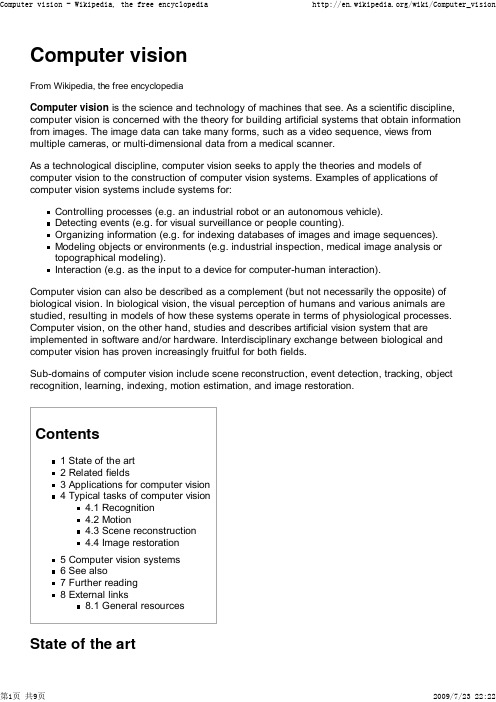
A third field which plays an important role is neurobiology, specifically the study of the biological vision system. Over the last century, there has been an extensive study of eyes, neurons, and the brain structures devoted to processing of visual stimuli in both humans and various animals. This has led to a coarse, yet complicated, description of how "real" vision systems operate in order to solve certain vision related tasks. These results have led to a subfield within computer vision where artificial systems are designed to mimic the processing and behaviour of biological systems, at different levels of complexity. Also, some of the learning-based methods developed within computer vision have their background in biology.Yet another field related to computer vision is signal processing. Many methods for processing of one-variable signals, typically temporal signals, can be extended in a natural way to processing of two-variable signals or multi-variable signals in computer vision. However, because of the specific nature of images there are many methods developed within computer vision which have no counterpart in the processing of one-variable signals. A distinct character of these methods is the fact that they are non-linear which, together with the multi-dimensionality of the signal, defines a subfield in signal processing as a part of computer vision.Beside the above mentioned views on computer vision, many of the related research topics can also be studied from a purely mathematical point of view. For example, many methods in computer vision are based on statistics, optimization or geometry. Finally, a significant part of the field is devoted to the implementation aspect of computer vision; how existing methods can be realized in various combinations of software and hardware, or how these methods can be modified in order to gain processing speed without losing too much performance.The fields most closely related to computer vision are image processing, image analysis, robot vision and machine vision. There is a significant overlap in the range of techniques and applications that these cover. This implies that the basic techniques that are used and developed in these fields are more or less identical, something which can be interpreted as there is only one field with different names. On the other hand, it appears to be necessary for research groups, scientific journals, conferences and companies to present or market themselves as belonging specifically to one of these fields and, hence, various characterizations which distinguish each of the fields from the others have been presented.The following characterizations appear relevant but should not be taken as universally accepted: Image processing and image analysis tend to focus on 2D images, how to transform one image to another, e.g., by pixel-wise operations such as contrast enhancement, localoperations such as edge extraction or noise removal, or geometrical transformations such as rotating the image. This characterization implies that image processing/analysis neither require assumptions nor produce interpretations about the image content.Computer vision tends to focus on the 3D scene projected onto one or several images, e.g., how to reconstruct structure or other information about the 3D scene from one or several images. Computer vision often relies on more or less complex assumptions about the scene depicted in an image.Machine vision tends to focus on applications, mainly in industry, e.g., vision basedautonomous robots and systems for vision based inspection or measurement. This implies that image sensor technologies and control theory often are integrated with the processing of image data to control a robot and that real-time processing is emphasized by means of efficient implementations in hardware and software. It also implies that the externalconditions such as lighting can be and are often more controlled in machine vision thanthey are in general computer vision, which can enable the use of different algorithms.There is also a field called imaging which primarily focus on the process of producingexploration is already being made with autonomous vehicles using computer vision, e. g., NASA's Mars Exploration Rover.Other application areas include:Support of visual effects creation for cinema and broadcast, e.g., camera tracking(matchmoving).Surveillance.Typical tasks of computer visionEach of the application areas described above employ a range of computer vision tasks; more or less well-defined measurement problems or processing problems, which can be solved using a variety of methods. Some examples of typical computer vision tasks are presented below.RecognitionThe classical problem in computer vision, image processing and machine vision is that of determining whether or not the image data contains some specific object, feature, or activity. This task can normally be solved robustly and without effort by a human, but is still not satisfactorily solved in computer vision for the general case: arbitrary objects in arbitrary situations. The existing methods for dealing with this problem can at best solve it only for specific objects, such as simple geometric objects (e.g., polyhedrons), human faces, printed or hand-written characters, or vehicles, and in specific situations, typically described in terms of well-defined illumination, background, and pose of the object relative to the camera.Different varieties of the recognition problem are described in the literature:Recognition: one or several pre-specified or learned objects or object classes can berecognized, usually together with their 2D positions in the image or 3D poses in the scene.Identification: An individual instance of an object is recognized. Examples: identification ofa specific person's face or fingerprint, or identification of a specific vehicle.Detection: the image data is scanned for a specific condition. Examples: detection ofpossible abnormal cells or tissues in medical images or detection of a vehicle in anautomatic road toll system. Detection based on relatively simple and fast computations is sometimes used for finding smaller regions of interesting image data which can be further analyzed by more computationally demanding techniques to produce a correctinterpretation.Several specialized tasks based on recognition exist, such as:Content-based image retrieval: finding all images in a larger set of images which have a specific content. The content can be specified in different ways, for example in terms ofsimilarity relative a target image (give me all images similar to image X), or in terms ofhigh-level search criteria given as text input (give me all images which contains manyhouses, are taken during winter, and have no cars in them).Pose estimation: estimating the position or orientation of a specific object relative to the camera. An example application for this technique would be assisting a robot arm inretrieving objects from a conveyor belt in an assembly line situation.Optical character recognition (or OCR): identifying characters in images of printed orhandwritten text, usually with a view to encoding the text in a format more amenable toediting or indexing (e.g. ASCII).MotionSeveral tasks relate to motion estimation, in which an image sequence is processed to produce an estimate of the velocity either at each points in the image or in the 3D scene. Examples of such tasks are:Egomotion: determining the 3D rigid motion of the camera.Tracking: following the movements of objects (e.g. vehicles or humans).Scene reconstructionGiven one or (typically) more images of a scene, or a video, scene reconstruction aims at computing a 3D model of the scene. In the simplest case the model can be a set of 3D points. More sophisticated methods produce a complete 3D surface model.Image restorationThe aim of image restoration is the removal of noise (sensor noise, motion blur, etc.) from images. The simplest possible approach for noise removal is various types of filters such as low-pass filters or median filters. More sophisticated methods assume a model of how the local image structures look like, a model which distinguishes them from the noise. By first analysing the image data in terms of the local image structures, such as lines or edges, and then controlling the filtering based on local information from the analysis step, a better level of noise removal is usually obtained compared to the simpler approaches.Computer vision systemsThe organization of a computer vision system is highly application dependent. Some systems are stand-alone applications which solve a specific measurement or detection problem, while other constitute a sub-system of a larger design which, for example, also contains sub-systems for control of mechanical actuators, planning, information databases, man-machine interfaces, etc. The specific implementation of a computer vision system also depends on if its functionality ispre-specified or if some part of it can be learned or modified during operation. There are, however, typical functions which are found in many computer vision systems.Image acquisition: A digital image is produced by one or several image sensors, which, besides various types of light-sensitive cameras, include range sensors, tomographydevices, radar, ultra-sonic cameras, etc. Depending on the type of sensor, the resultingimage data is an ordinary 2D image, a 3D volume, or an image sequence. The pixel values typically correspond to light intensity in one or several spectral bands (gray images orcolour images), but can also be related to various physical measures, such as depth,absorption or reflectance of sonic or electromagnetic waves, or nuclear magneticresonance.Pre-processing: Before a computer vision method can be applied to image data in order to extract some specific piece of information, it is usually necessary to process the data inorder to assure that it satisfies certain assumptions implied by the method. Examples are Re-sampling in order to assure that the image coordinate system is correct.Noise reduction in order to assure that sensor noise does not introduce falseinformation.Contrast enhancement to assure that relevant information can be detected.Scale-space representation to enhance image structures at locally appropriate scales.Feature extraction: Image features at various levels of complexity are extracted from theimage data. Typical examples of such features areLines, edges and ridges.Localized interest points such as corners, blobs or points.More complex features may be related to texture, shape or motion.Detection/Segmentation: At some point in the processing a decision is made about which image points or regions of the image are relevant for further processing. Examples are Selection of a specific set of interest pointsSegmentation of one or multiple image regions which contain a specific object ofinterest.High-level processing: At this step the input is typically a small set of data, for example a set of points or an image region which is assumed to contain a specific object. Theremaining processing deals with, for example:Verification that the data satisfy model-based and application specific assumptions.Estimation of application specific parameters, such as object pose or object size.Classifying a detected object into different categories.See alsoActive visionArtificial intelligence Digital image processing Image processing List of computer visiontopicsMachine learningMachine visionMachine Vision GlossaryMedical imagingPattern recognitionTopological data analysisFurther readingSorted alphabetically with respect to first author's family namePedram Azad, Tilo Gockel, Rüdiger Dillmann (2008). Computer Vision - Principles andPractice. Elektor International Media BV. ISBN 0905705718. /book.html.Dana H. Ballard and Christopher M. Brown (1982). Computer Vision. Prentice Hall. ISBN 0131653164. /rbf/BOOKS/BANDB/bandb.htm.Wilhelm Burger and Mark J. Burge (2007). Digital Image Processing: An AlgorithmicApproach Using Java. Springer. ISBN 1846283795 and ISBN 3540309403./.James L. Crowley and Henrik I. Christensen (Eds.) (1995). Vision as Process. Springer-Verlag. ISBN 3-540-58143-X and ISBN 0-387-58143-X.E. Roy Davies (2005). Machine Vision : Theory, Algorithms, Practicalities. MorganKaufmann. ISBN 0-12-206093-8.Olivier Faugeras (1993). Three-Dimensional Computer Vision, A Geometric Viewpoint. MIT Press. ISBN 0-262-06158-9.R. Fisher, K Dawson-Howe, A. Fitzgibbon, C. Robertson, E. Trucco (2005). Dictionary of Computer Vision and Image Processing. John Wiley. ISBN 0-470-01526-8.David A. Forsyth and Jean Ponce (2003). Computer Vision, A Modern Approach. Prentice Hall. ISBN 0-12-379777-2.Gösta H. Granlund and Hans Knutsson (1995). Signal Processing for Computer Vision.Kluwer Academic Publisher. ISBN 0-7923-9530-1.Richard Hartley and Andrew Zisserman (2003). Multiple View Geometry in Computer Vision.Cambridge University Press. ISBN 0-521-54051-8.Berthold Klaus Paul Horn (1986). Robot Vision. MIT Press. ISBN 0-262-08159-8.Fay Huang, Reinhard Klette and Karsten Scheibe (2008). Panoramic Imaging - Sensor-Line Cameras and Laser Range-Finders. Wiley. ISBN 978-0-470-06065-0.Bernd Jähne and Horst Haußecker (2000). Computer Vision and Applications, A Guide for Students and Practitioners. Academic Press. ISBN 0-13-085198-1.Bernd Jähne (2002). Digital Image Processing. Springer. ISBN 3-540-67754-2.Reinhard Klette, Karsten Schluens and Andreas Koschan (1998). Computer Vision - Three-Dimensional Data from Images. Springer, Singapore. ISBN 981-3083-71-9.Tony Lindeberg (1994). Scale-Space Theory in Computer Vision. Springer. ISBN0-7923-9418-6. http://www.nada.kth.se/~tony/book.html.David Marr (1982). Vision. W. H. Freeman and Company. ISBN 0-7167-1284-9.Gérard Medioni and Sing Bing Kang (2004). Emerging Topics in Computer Vision. Prentice Hall. ISBN 0-13-101366-1.Tim Morris (2004). Computer Vision and Image Processing. Palgrave Macmillan. ISBN0-333-99451-5.Nikos Paragios and Yunmei Chen and Olivier Faugeras (2005). Handbook of Mathematical Models in Computer Vision. Springer. ISBN 0-387-26371-3.Azriel Rosenfeld and Avinash Kak (1982). Digital Picture Processing. Academic Press. ISBN 0-12-597301-2.Linda G. Shapiro and George C. Stockman (2001). Computer Vision. Prentice Hall. ISBN 0-13-030796-3.Milan Sonka, Vaclav Hlavac and Roger Boyle (1999). Image Processing, Analysis, andMachine Vision. PWS Publishing. ISBN 0-534-95393-X.Emanuele Trucco and Alessandro Verri (1998). Introductory Techniques for 3-D Computer Vision. Prentice Hall. ISBN 0132611082.External linksGeneral resourcesKeith Price's Annotated Computer Vision Bibliography (/Vision-Notes/bibliography/contents.html) and the Official Mirror Site Keith Price's AnnotatedComputer Vision Bibliography (/bibliography/contents.html)USC Iris computer vision conference list (/Information/Iris-Conferences.html)Retrieved from "/wiki/Computer_vision"Categories: Artificial intelligence | Computer visionThis page was last modified on 30 June 2009 at 03:36.Text is available under the Creative Commons Attribution/Share-Alike License; additional terms may apply. See Terms of Use for details.Wikipedia® is a registered trademark of the Wikimedia Foundation, Inc., a non-profitorganization.。
简述霍夫变换过程

简述霍夫变换过程
霍夫变换是一种特征提取(feature extraction),被广泛应用在图像分析(image analysis)、计算机视觉(computer vision)以及数位影像处理(digital image processing)。
霍夫变换是用来辨别找出物件中的特征,例如:线条。
他的算法流程大致如下,给定一个物件、要辨别的形状的种类,算法会在参数空间(parameter space)中执行投票来决定物体的形状,而这是由累加空间(accumulator space)里的局部最大值(local maximum)来决定。
现在广泛使用的霍夫变换是由
RichardDuda和PeterHart在公元1972年发明,并称之为广义霍夫变换(generalizedHoughtransform),广义霍夫变换和更早前1962年的PaulHough的专利有关。
经典的霍夫变换是侦测图片中的直线,之后,霍夫变换不仅能识别直线,也能够识别任何形状,常见的有圆形、椭圆形。
1981年,因为DanaH.Ballard的一篇期刊论文"Generalizing the Hough transform to detect arbitrary shapes",让霍夫变换开始流行于计算机视觉界。
图像分析与识别ppt课件

识
别
数值计算,满足不了处理大数据量图像
的要求。
编辑课件
29
图 第 ➢ 在上世纪60年代,第3代计算机的研制成
像一
分 章 功,以及快速傅里叶变换算法的发现和
析引 与言
应用使得对图像的某些计算得以实现。
识
别 ➢ 人们从而逐步开始利用计算机对图像进
行加工利用。
编辑课件
30
图 第 ➢ 在上世纪70年代,数字图像处理技术有
别
头部CT
编辑课件
52
超声波成像的实例
图第 像一 分章 析引 与言 识 别
甲状腺
肌肉层有损害
编辑课件
53
图 第 ➢ 在医学中,无线电波可以用于核磁共振
像一
分 章 成像(MRI),是继CT后医学影像学的
析引 与言
又一重大进步。
识 ➢ 相对于X-射线透视技术和放射造影技术,
别
MRI对人体没有辐射影响,相对于超声
析引
与 言 ➢ 现在利用图像处理系统进行判读分析,
识
别
既可以提高效率,又可以从照片中提取
人工所不能发现的大量的有用情报。
编辑课件
35
图 第 ➢ 遥感技术分为飞机遥感和卫星遥感技术。
像一
分章 析引
➢ 从遥感卫星所获得的图像的图像质量有
与 言 时不是很好,如果仍采用简单的直观判
识
别
读如此昂贵代价所获取的的图像是不合
图第 像一 分章 析引 与言 识 别
编辑课件
43
High-pass filtering (HPF) 图像融合算法
图第 像一 分章 析引 与言 识 别
编辑课件
44
High-pass modulation (HPM) 图像融合算法
SCI(图像-计算机视觉-测量)
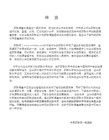
63 Chinese Optics Letters 4 0.822 物理类
64 IEEE Transactions on Information Forensics and Security 3 1.835 信息安全领域,CCF划定的顶级期刊,极为难中。国内极少能中的。终极奋斗目标!知道就行了啊,10%以内
IEEE TRANSACTIONS ON IMAGE PROCESSING 2 2.936(TIP)高
(备注:一区IEEE T PAMI ,INT J COMPUTER VISION 二区IEEE T IMAGE PROCESSSION ,pattern recognition)
1.CVIU:Computer Vision and Image Understanding 1.85(老牌杂志,但审稿期巨长,慎重)
42 Journal of Logic and Computation 4 0.662 影响因子,0.789,SCI检索
43 Journal of Signal Processing Systems for Signal Image and Video Technology
44 COMPUTER METHODS IN APPLIED MECHANICS AND ENGINEERING 2 2.181 影响因子偏低,但仍然需要一定水平才可以投,审稿2--4周,SCI,EI检索
40 information processing letters 4 0.661 计算机领域的,收录短文,审稿慢啊,发表快,影响因子低0.5左右,接搞量大,容易发表,审稿周期一般3--6个月
图像直方图实验报告
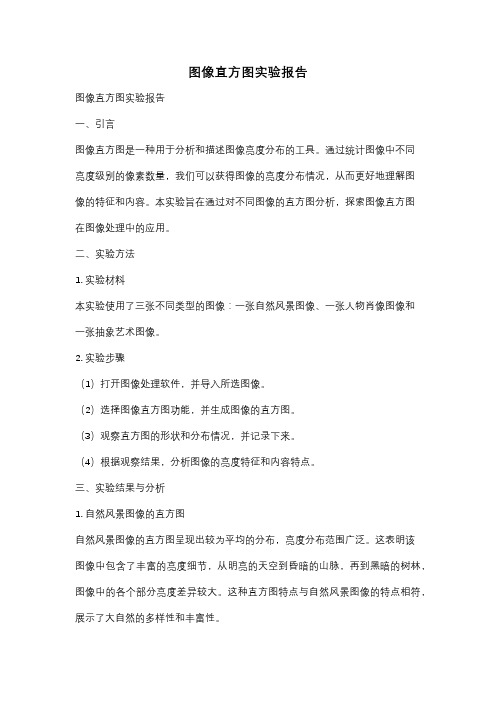
图像直方图实验报告图像直方图实验报告一、引言图像直方图是一种用于分析和描述图像亮度分布的工具。
通过统计图像中不同亮度级别的像素数量,我们可以获得图像的亮度分布情况,从而更好地理解图像的特征和内容。
本实验旨在通过对不同图像的直方图分析,探索图像直方图在图像处理中的应用。
二、实验方法1. 实验材料本实验使用了三张不同类型的图像:一张自然风景图像、一张人物肖像图像和一张抽象艺术图像。
2. 实验步骤(1)打开图像处理软件,并导入所选图像。
(2)选择图像直方图功能,并生成图像的直方图。
(3)观察直方图的形状和分布情况,并记录下来。
(4)根据观察结果,分析图像的亮度特征和内容特点。
三、实验结果与分析1. 自然风景图像的直方图自然风景图像的直方图呈现出较为平均的分布,亮度分布范围广泛。
这表明该图像中包含了丰富的亮度细节,从明亮的天空到昏暗的山脉,再到黑暗的树林,图像中的各个部分亮度差异较大。
这种直方图特点与自然风景图像的特点相符,展示了大自然的多样性和丰富性。
2. 人物肖像图像的直方图人物肖像图像的直方图呈现出较为集中的分布,亮度主要集中在中间区域。
这表明该图像中的人物主体亮度较为均匀,没有明显的高光或阴影。
这种直方图特点与人物肖像图像的特点相符,突出了人物的面部特征和表情。
3. 抽象艺术图像的直方图抽象艺术图像的直方图呈现出较为离散的分布,亮度分布呈现出一定的规律性。
这表明该图像中存在着一些重复出现的亮度模式或纹理。
这种直方图特点与抽象艺术图像的特点相符,强调了艺术家对于形式和结构的探索。
四、实验总结通过对不同类型图像的直方图分析,我们可以发现图像直方图与图像内容和特征之间存在一定的关联性。
自然风景图像的直方图展示了大自然的多样性和丰富性,人物肖像图像的直方图突出了人物的面部特征和表情,抽象艺术图像的直方图强调了艺术家对于形式和结构的探索。
因此,在图像处理中,我们可以通过对图像直方图的分析,更好地理解图像的内容和特征,为后续的图像处理工作提供参考。
Electronic Letters on Computer Vision and Image Analysis 5(4)75-82, 2006 Architectural Scen
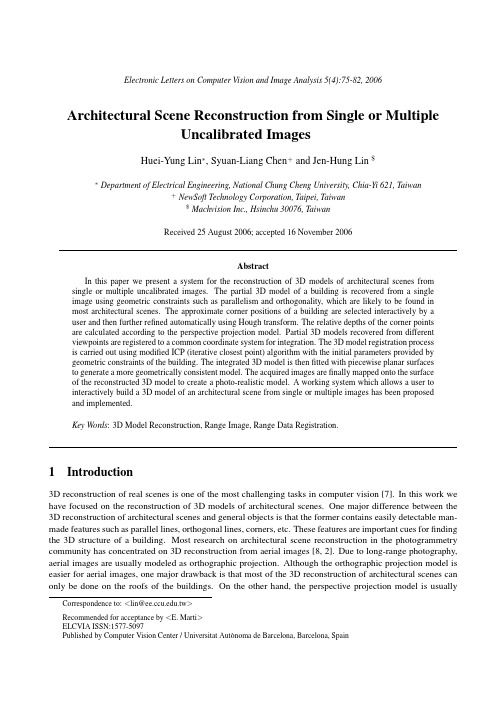
Abstract In this paper we present a system for the reconstruction of 3D models of architectural scenes from single or multiple uncalibrated images. The partial 3D model of a building is recovered from a single image using geometric constraints such as parallelism and orthogonality, which are likely to be found in most architectural scenes. The approximate corner positions of a building are selected interactively by a user and then further refined automatically using Hough transform. The relative depths of the corner points are calculated according to the perspective projection model. Partial 3D models recovered from different viewpoints are registered to a common coordinate system for integration. The 3D model registration process is carried out using modified ICP (iterative closest point) algorithm with the initial parameters provided by geometric constraints of the building. The integrated 3D model is then fitted with piecewise planar surfaces to generate a more geometrically consistent model. The acquired images are finally mapped onto the surface of the reconstructed 3D model to create a photo-realistic model. A working system which allows a user to interactively build a 3D model of an architectural scene from single or multiple images has been proposed and implemented. Key Words: 3D Model Reconstruction, Range Image, Range Data Registration.
图像处理和计算机视觉--基础,经典以及最近发展
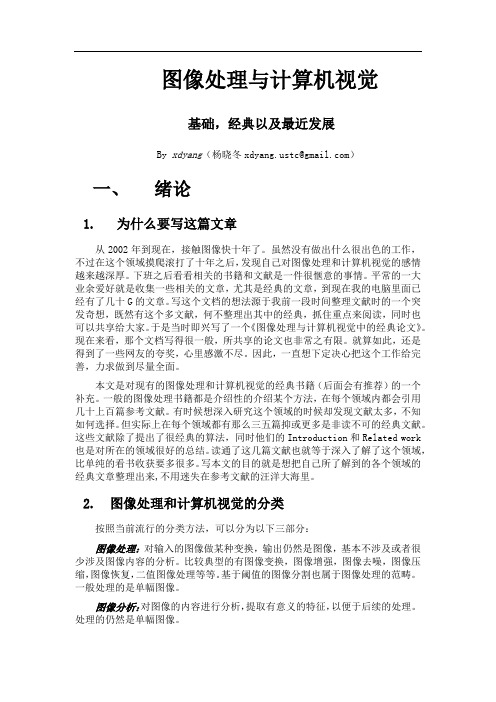
图像处理与计算机视觉基础,经典以及最近发展By xdyang(杨晓冬tc@)一、绪论1.为什么要写这篇文章从2002年到现在,接触图像快十年了。
虽然没有做出什么很出色的工作,不过在这个领域摸爬滚打了十年之后,发现自己对图像处理和计算机视觉的感情越来越深厚。
下班之后看看相关的书籍和文献是一件很惬意的事情。
平常的一大业余爱好就是收集一些相关的文章,尤其是经典的文章,到现在我的电脑里面已经有了几十G的文章。
写这个文档的想法源于我前一段时间整理文献时的一个突发奇想,既然有这个多文献,何不整理出其中的经典,抓住重点来阅读,同时也可以共享给大家。
于是当时即兴写了一个《图像处理与计算机视觉中的经典论文》。
现在来看,那个文档写得很一般,所共享的论文也非常之有限。
就算如此,还是得到了一些网友的夸奖,心里感激不尽。
因此,一直想下定决心把这个工作给完善,力求做到尽量全面。
本文是对现有的图像处理和计算机视觉的经典书籍(后面会有推荐)的一个补充。
一般的图像处理书籍都是介绍性的介绍某个方法,在每个领域内都会引用几十上百篇参考文献。
有时候想深入研究这个领域的时候却发现文献太多,不知如何选择。
但实际上在每个领域都有那么三五篇抑或更多是非读不可的经典文献。
这些文献除了提出了很经典的算法,同时他们的Introduction和Related work 也是对所在的领域很好的总结。
读通了这几篇文献也就等于深入了解了这个领域,比单纯的看书收获要多很多。
写本文的目的就是想把自己所了解到的各个领域的经典文章整理出来,不用迷失在参考文献的汪洋大海里。
2.图像处理和计算机视觉的分类按照当前流行的分类方法,可以分为以下三部分:图像处理:对输入的图像做某种变换,输出仍然是图像,基本不涉及或者很少涉及图像内容的分析。
比较典型的有图像变换,图像增强,图像去噪,图像压缩,图像恢复,二值图像处理等等。
基于阈值的图像分割也属于图像处理的范畴。
一般处理的是单幅图像。
图像去噪的基本原理、典型方法和最新方法 电子技术专业毕业设计 毕业论

摘要数字图像在其形成、传输和记录的过程中,由于成像系统、传输介质和记录设备的不完善往往使得获取的图像受到多种噪声的污染。
因此在模式识别、计算机视觉、图像分析和视频编码等领域,噪声图像的前期处理极其重要,其处理效果的好坏将直接影响到后续工作的质量和结果。
本文主要介绍图像去噪的基本原理、典型方法和最新方法。
考虑到图像去噪技术的飞速发展,本文在论述其基本理论的同时还着重介绍近年来国内有关的最新研究成果和最新方法。
本文被分成四个部分。
第一部分是绪论,论述图像去噪发展趋势及研究图像去噪的理由与意义。
第二部分论述中值滤波法和自适应平滑滤波法的基本原理,完成基于matlab中值滤波的代码实现,并对其结果进行分析。
本文提出两种新的算法,即中值滤波的改进算法即自适应加权算法,和自适应平滑滤波的改进算法。
并且也得出这两种算法的仿真结果,并且对结果进行分析。
第三部分首先论述基于频域的图像去噪方法的基本原理,然后本文对巴特沃斯低通滤波和巴特沃斯高通滤波的基本原理作了论述,并且分别完成基于matlab的巴特沃斯低通滤波和高通滤波的代码实现,对结果进行分析。
同时对程序中的重要语句分别作注释。
第四部分是本文最重要的一章,重点阐述基于小波域的两种图像去噪方法和算法,即小波阈值去噪法与小波维纳滤波去噪法。
在小波阈值去噪法中,本文重点论述小波阈值去噪的三个步骤,并介绍传统经典的阈值化方法即软阈值法、硬阈值法以及四种确定阈值的方法。
其中包括统一阈值法、基于零均值正态分布的置信区间阈值、最小最大阈值法和理想阈值估计法,并且完成小波阈值去噪法的代码实现,将小波阈值去噪法的去噪结果和中值滤波法的去噪结果进行比较分析,得出结论。
在小波维纳滤波去噪法中本文着重论述小波维纳滤波去噪法的基本原理,得到小波维纳滤波去噪法的仿真结果,并且将波维纳滤波去噪法的结果与维纳滤波去噪法的结果进行对比分析。
关键词:图像去噪,维纳滤波,中值滤波,小波变换,阈值AbstractIn its formation, transmission and recording of the process of digital images, because imaging system , transmission media and recording equipment are often imperfect, the obtained images are polluted by a variety of noises. In pattern recognition, computer vision, image analysis and video coding and other fields,noise image pre-processing is extremely important and whether its effect is good or bad will have a direct impact on the following quality and results. This paper introduces the basic principle, the typical method and the latest methods of image denoising.Taking the rapid development of technology of image denoising into account, the paper discusses the basic theory and at the same time also the latest research results and the latest methods in recent years.This paper is divided into four parts.introduction The first part is the introduction and discusses development trend of image denoising and the reasons and significance of studying image denoising. The second part, deals with the basic principles of median filter and adaptive smoothing filter, achieves the completion of median filtering code based on Matlab, and analyzes the results. This paper presents two new algorithm, which is the improved algorithms of the filtering called adaptive weighted algorithm, and the improved algorithm of adaptive smoothing. And the paper has reached this algorithm simulation results, and analyzed the results. The third part firstly discusses the basic principles of image denoising based on frequency domain . Then this paper discusses the basic principles of Butterworth low-pass filter and Butterworth high-pass filtering, and completes the code achieved based on Matlab Butterworth low-pass filter and high-pass filtering and analyzes the results. Meanwhile important statements of the procedures are explained. The fourth part of this article is the most important chapter and focuses on the two methods and algorithms of image denoising based on wavelet domain, which are the wavelet domain thresholding method and wavelet wiener filter method. In wavelet thresholding method, the paper focuses on the three steps of wavelet thresholding and discusses the traditional classical threshold methods,which are soft, and the threshold hard threshold law, and introduces four ways of determining the threshold.The four ways include a single threshold value, intervalthreshold based on the zero mean normal confidence, the largest minimum threshold value and ideal threshold estimates.The paper completes achieving code of wavelet thresholding method and comparatively analyzes the results of wavelet thresholding method and the results of denoising filter method. In wavelet wiener filter ,the paper method focuses on the basic principle of wavelet wiener filter, achieves simulation results of wavelet wiener filter method, and compares the results of wavelet wiener filter method with the results of the wiener filter method.Keywords : image denoising, Wiener filter, filtering, wavelet transform, threshold第1章绪论1.1 图像去噪的发展趋势图像信号处理中最困难的问题之一是:怎样滤出图像中的噪声而又不模糊图像的特征及边缘。
图像处理综合实验报告

图像处理综合实验报告一、引言图像处理是计算机科学中的重要研究领域,其应用范围广泛,涵盖了图像增强、图像分割、图像识别等多个方面。
本实验旨在通过综合实验的方式,探索图像处理的基本方法和技术,并对实验结果进行分析和总结。
二、实验目的1. 了解图像处理的基本概念和原理;2. 熟悉常用的图像处理工具和算法;3. 掌握图像处理中常见的操作和技术;4. 分析实验结果并提出改进意见。
三、实验步骤1. 实验准备在实验开始之前,我们需要准备一台计算机和图像处理软件,例如MATLAB、Python等。
同时,需要收集一些图像数据作为实验样本。
2. 图像增强图像增强是图像处理中常用的操作,旨在改善图像的质量和视觉效果。
我们可以通过调整图像的亮度、对比度、色彩等参数来实现图像增强。
在实验中,我们可以选择一些常见的图像增强算法,如直方图均衡化、灰度拉伸等。
3. 图像滤波图像滤波是图像处理中常用的技术,用于去除图像中的噪声和平滑图像。
常见的图像滤波算法包括均值滤波、中值滤波、高斯滤波等。
在实验中,我们可以选择适合实验样本的滤波算法,并对比不同滤波算法的效果。
4. 图像分割图像分割是将图像划分为不同的区域或对象的过程。
常见的图像分割算法包括阈值分割、边缘检测、区域生长等。
在实验中,我们可以选择一种或多种图像分割算法,并对比它们的分割效果和计算复杂度。
5. 图像识别图像识别是图像处理的重要应用之一,它可以用于识别和分类图像中的对象或特征。
在实验中,我们可以选择一些常用的图像识别算法,如模板匹配、神经网络等,并通过实验样本进行图像识别的实验。
四、实验结果与分析1. 图像增强实验结果我们选取了一张低对比度的图像作为实验样本,经过直方图均衡化和灰度拉伸处理后,图像的对比度得到了明显的改善,细节部分更加清晰。
2. 图像滤波实验结果我们选取了一张带有高斯噪声的图像作为实验样本,经过均值滤波、中值滤波和高斯滤波处理后,图像的噪声得到了有效的去除,图像更加平滑。
计算机视觉技术的研究和应用
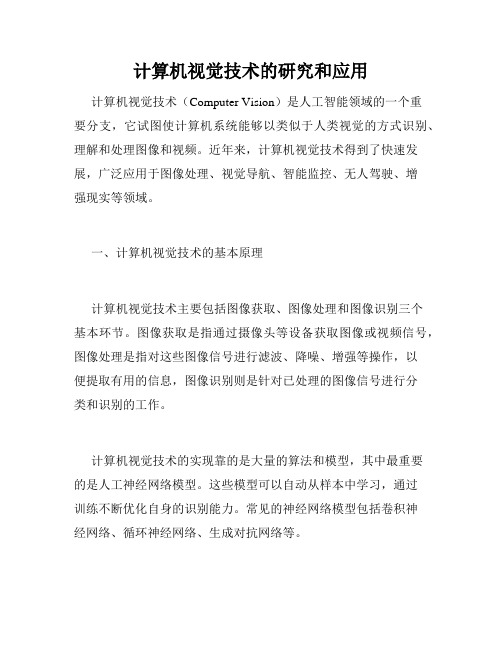
计算机视觉技术的研究和应用计算机视觉技术(Computer Vision)是人工智能领域的一个重要分支,它试图使计算机系统能够以类似于人类视觉的方式识别、理解和处理图像和视频。
近年来,计算机视觉技术得到了快速发展,广泛应用于图像处理、视觉导航、智能监控、无人驾驶、增强现实等领域。
一、计算机视觉技术的基本原理计算机视觉技术主要包括图像获取、图像处理和图像识别三个基本环节。
图像获取是指通过摄像头等设备获取图像或视频信号,图像处理是指对这些图像信号进行滤波、降噪、增强等操作,以便提取有用的信息,图像识别则是针对已处理的图像信号进行分类和识别的工作。
计算机视觉技术的实现靠的是大量的算法和模型,其中最重要的是人工神经网络模型。
这些模型可以自动从样本中学习,通过训练不断优化自身的识别能力。
常见的神经网络模型包括卷积神经网络、循环神经网络、生成对抗网络等。
二、计算机视觉技术的应用领域1. 图像处理计算机视觉技术在图像处理领域中得到了广泛应用。
例如,人们利用计算机视觉技术对图像进行滤波、降噪、增强等处理,以便清晰地显示出图片中包含的信息。
此外,计算机视觉技术还可以应用于图像复原、图像分割、图像配准等诸多方面。
2. 视觉导航视觉导航是机器人等智能设备实现自主定位和路径规划的核心技术之一。
目前,大量的无人机、机器人、AGV(自动引导车)等自主导航系统已经应用了计算机视觉技术。
通过计算机视觉技术,它们可以获得周围环境的信息,从而判断自身位置以及运动的方向和速度。
3. 智能监控和安防计算机视觉技术在智能监控和安防领域中也有广泛的应用。
利用计算机视觉技术可以提取图像中的人脸、车辆、行人等目标的各种特征,进而实现各种智能监控和安防功能。
例如,可以通过人脸识别技术实现门禁系统的高效、准确的识别;通过车辆识别技术实现智能交通管理等。
4. 无人驾驶无人驾驶是计算机视觉技术应用的一个重要领域。
人们利用计算机视觉技术对车辆周围的环境信息进行处理,从而实现车辆的自主导航和避免碰撞。
插值算法书籍
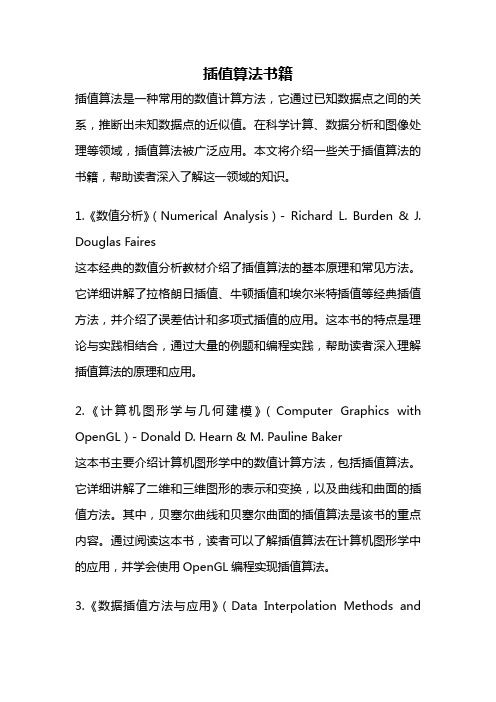
插值算法书籍插值算法是一种常用的数值计算方法,它通过已知数据点之间的关系,推断出未知数据点的近似值。
在科学计算、数据分析和图像处理等领域,插值算法被广泛应用。
本文将介绍一些关于插值算法的书籍,帮助读者深入了解这一领域的知识。
1.《数值分析》(Numerical Analysis)- Richard L. Burden & J. Douglas Faires这本经典的数值分析教材介绍了插值算法的基本原理和常见方法。
它详细讲解了拉格朗日插值、牛顿插值和埃尔米特插值等经典插值方法,并介绍了误差估计和多项式插值的应用。
这本书的特点是理论与实践相结合,通过大量的例题和编程实践,帮助读者深入理解插值算法的原理和应用。
2.《计算机图形学与几何建模》(Computer Graphics with OpenGL)- Donald D. Hearn & M. Pauline Baker这本书主要介绍计算机图形学中的数值计算方法,包括插值算法。
它详细讲解了二维和三维图形的表示和变换,以及曲线和曲面的插值方法。
其中,贝塞尔曲线和贝塞尔曲面的插值算法是该书的重点内容。
通过阅读这本书,读者可以了解插值算法在计算机图形学中的应用,并学会使用OpenGL编程实现插值算法。
3.《数据插值方法与应用》(Data Interpolation Methods andApplications)- Myron J. Block这本书介绍了数据插值方法的理论和实践应用。
它详细讲解了一维和多维数据的插值算法,包括线性插值、样条插值、径向基函数插值等。
同时,该书还介绍了插值算法在地理信息系统(GIS)、遥感图像处理和气象预报等领域的应用。
通过学习这本书,读者可以了解插值算法在不同领域中的具体应用场景,并能够选择合适的插值方法解决实际问题。
4.《图像处理与计算机视觉》(Image Processing and Computer Vision)- Milan Sonka, Vaclav Hlavac & Roger Boyle这本书主要介绍图像处理和计算机视觉中的数值计算方法,包括插值算法。
计算机视觉PPT教案

第20页/共204页
2021/8/2
相关学科
图像处理与图像分析 研究对象主要是二维图像,实现图像的转化, 尤其针对像素级的操作,例如提高图像对 比度,边缘提取,去噪声和几何变换如图 像旋转。这一特征表明无论是图像处理还 是图像分析其研究内容都和图像的具体内 容无关。
第21页/共204页
2021/8/2
第28页/共204页
2021/8/2
需要解决的几个经典问题
运动
自体运动:摄像机/成像设备的三维刚性运动(3D成像演示7、27、28 )
图像跟踪:跟踪运动的物体。(车辆轨迹跟踪(8) 、人员计数演示 ) (9)
第29页/共204页
2021/8/2
需要解决的几个经典问题
场景重建
给定一个场景的二或多幅图像或者一段录像,场景重建寻求为该
觉研究人
员来讲是
非常具有
第38页/共204页
启发性和
2021/8/2
伽马射线: 核医学和天文观察 在核医学中,将放射 性同位素注射到病人 体内,当这种物质衰 变时放射出伽马射 线,利用检测器收集 到的放射物产生图像。 可以确定骨骼病理、 感染或肿瘤等。
第39页/共204页
2021/8/2
X射线:医学诊断等 紫外线:荧光显微镜
主要参考资料
《计算机视觉》
(美国)夏皮罗 (美国)斯托克曼 赵清杰 等译
机械工业出版社
《计算机视觉:计算理论与算法基础》
马德颂
《机器视觉算法与应用》
(德)斯蒂格 (德)尤里奇 (德)威德曼著 杨少荣等译
第37页/共204页
2021/8/2
一. 视觉原理
了解人类
视觉的构
成、信息
大模型应用场景英文术语
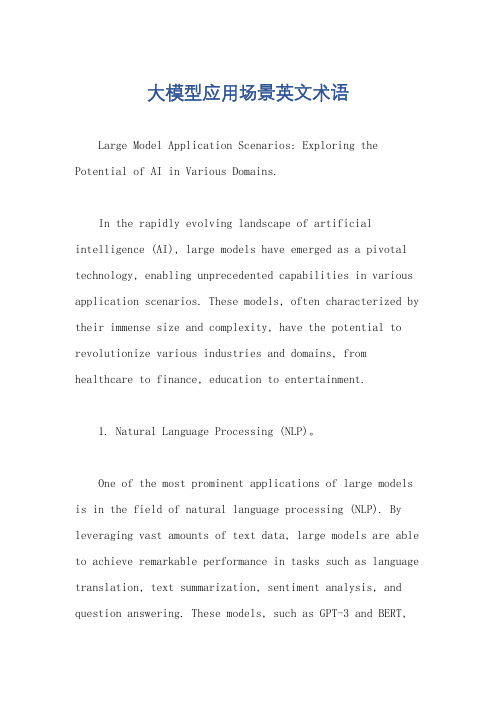
大模型应用场景英文术语Large Model Application Scenarios: Exploring the Potential of AI in Various Domains.In the rapidly evolving landscape of artificial intelligence (AI), large models have emerged as a pivotal technology, enabling unprecedented capabilities in various application scenarios. These models, often characterized by their immense size and complexity, have the potential to revolutionize various industries and domains, from healthcare to finance, education to entertainment.1. Natural Language Processing (NLP)。
One of the most prominent applications of large models is in the field of natural language processing (NLP). By leveraging vast amounts of text data, large models are able to achieve remarkable performance in tasks such as language translation, text summarization, sentiment analysis, and question answering. These models, such as GPT-3 and BERT,have demonstrated their prowess in understanding and generating human language, enabling more natural andintuitive interactions between humans and machines.2. Image Recognition and Computer Vision.Large models have also made significant strides in the realm of image recognition and computer vision. Byanalyzing vast amounts of visual data, these models areable to identify objects, scenes, and patterns with remarkable accuracy. This has led to numerous applicationsin fields such as autonomous driving, security surveillance, and medical imaging. Large models have the potential to revolutionize these industries by enabling more reliableand efficient visual analysis.3. Recommendation Systems.In the era of information overload, recommendation systems have become increasingly important. Large models, with their ability to analyze vast amounts of user data, have the potential to.。
人工智能与计算机视觉的主要研究内容

人工智能与计算机视觉的主要研究内容人工智能(Artificial Intelligence, AI)是一门研究如何使计算机能够像人一样思考和行动的学科。
而计算机视觉(Computer Vision)是人工智能中的一个重要分支,旨在使计算机能够理解和解释图像和视频,并从中获取有用的信息。
人工智能与计算机视觉的研究内容非常广泛,以下将重点介绍其中的几个主要方向。
1. 图像分类与识别图像分类与识别是计算机视觉研究的基础和核心问题之一。
它的目标是让计算机能够根据图像的内容将其分为不同的类别。
研究人员通常使用深度学习等机器学习技术,通过构建大规模图像数据集和训练模型来实现图像分类与识别的任务。
2. 目标检测与跟踪目标检测与跟踪是计算机视觉中的重要问题,其目标是在图像或视频中准确地检测和跟踪特定的目标。
这项研究对于实现自动驾驶、视频监控等应用具有重要意义。
研究人员使用了许多算法和技术,如卷积神经网络(Convolutional Neural Networks, CNN)和循环神经网络(Recurrent Neural Networks, RNN),以提高目标检测和跟踪的准确性和效率。
3. 图像生成与合成图像生成与合成是计算机视觉中的一个重要研究方向,其主要目标是使用计算机生成逼真的图像或合成新的图像。
这项研究对于虚拟现实、游戏开发等领域具有重要意义。
研究人员使用了生成对抗网络(Generative Adversarial Networks, GAN)等技术,通过训练生成模型来生成逼真的图像。
4. 三维重建与立体视觉三维重建与立体视觉是计算机视觉中的一个重要研究方向,其目标是根据二维图像或视频重建出场景的三维结构。
这项研究对于增强现实、机器人导航等应用具有重要意义。
研究人员使用了立体匹配、结构光等技术,通过图像间的几何关系来重建三维场景。
5. 视觉理解与推理视觉理解与推理是计算机视觉中的一个重要研究方向,其目标是让计算机能够理解图像或视频中的语义和语境信息,并进行推理和判断。
图像目标对称性检测方法研究毕业设计(论文)
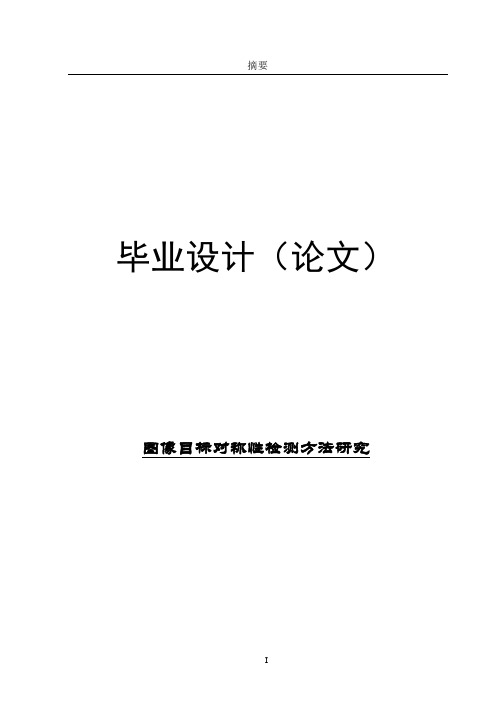
摘要毕业设计(论文)图像目标对称性检测方法研究燕山大学本科生毕业设计(论文)摘要本文介绍一种新的检测图像对称性的方法。
它使用原始图像的相位信息,而不使用图像梯度信息。
由于相位信息的稳定性和重要性,该方法具有很强的鲁棒性,不受图像亮度、对比度和旋转的影响。
它能检测镜像对称性,旋转对称性和曲线对称性,不需要图像分割等任何预处理。
实验结果证明了该方法的有效性和鲁棒性。
对称性是物体与形状的基本特征之一,在图像分析和计算机视觉等领域是一个重要的研究课题,形状的对称性描述和物体对称性检测在机器人识别、检验、抓取和推理中有重要应用。
本文还给出各种对称性的严格数学定义,综述了现有各种对称性检测方法,并比较其优缺点,提出了简单通用的基于隐含多项式曲线对称性检测方法。
关键词logGabor小波变换,相位信息,对称性检测燕山大学本科生毕业设计(论文)AbstractIn this paper, a new method of image symmetry detection is introduced.Instead of gradient information,it uses phase information of original image.Because of phase information’s stability and significance,this method is fairly robust,that is,it is invariant to illuminate,contrast,and rotation.It call detect mirror symmetry, rotating symmetry and curve symmetry at the same time. And it needs not an y preprocessing,such as segmentation.The experiments show that this method ’s effectiveness and robustness.The symmetry detection of the object is important research area in image analysis and computer vision, and is usually applied in shape matching, model-based object matching, reconstruction of 3D objects, image compression, image database retrieval and so on. This paper defines some of the symmetries by using the representation of mathematics, summarizes the existing methods of symmetries detection by now, and compares their advantages and disadvantages. Furthermore, the paper suggests research directions on the symmetry detection based on the implicit polynomials.Keywords LogGabor wavelets transform, Phase information, Symmetry detection.目录摘要 (II)Abstract (II)第1章绪论 (1)1.1 图像与数字图像 (1)1.2 图像处理技术内容与相关学科 (2)1.3 图像处理技术的发展现状 (4)1.4 图像处理技术的应用领域 (5)1.5 本章小结 (5)第2章对称性 (7)2.1对称性的国内外研究动态 (7)2.2 几种对称性的数学定义 (7)2.2.1 依据几何变换理论的对称性分类 (7)2.2.2 依据物体内部几何关系的对称性分类 (8)2.3 对称性检测方法 (9)2.3.1 模式匹配法 (9)2.3.2 优化搜索方法 (10)2.3.3 统计方法 (11)2.3.4 曲线微分法 (12)2.4 本章小结 (13)第3章对称性检测 (15)3.1基于隐含多项式曲线的对称性检测 (15)3.1.1 基于拐角点的对称性检测 (15)3.1.2 基于曲线微分性质的对称性检测 (16)3.2 边缘检测的MATLAB实现方法 (17)3.2.1 利用轮廓分布信息分析 (18)燕山大学本科生毕业设计(论文)3.3 利用相位法的对称性检测 (21)3.3.1 利用相位信息检测对称性原理 (23)3.3.2 算法的具体实现 (25)3.3.3 实验结果与分析 (26)3.4 本章小结 (29)结论 (30)参考文献 (31)附录1 (33)附录2 (37)附录3 (40)致谢 (55)第1章绪论第1章绪论1.1 图像与数字图像图像就是各种观测系统以不同形式和手段观测客观世界而获得的,可以直接或间接作用与人眼而产生视知觉的实体。
计算机视觉相关书籍
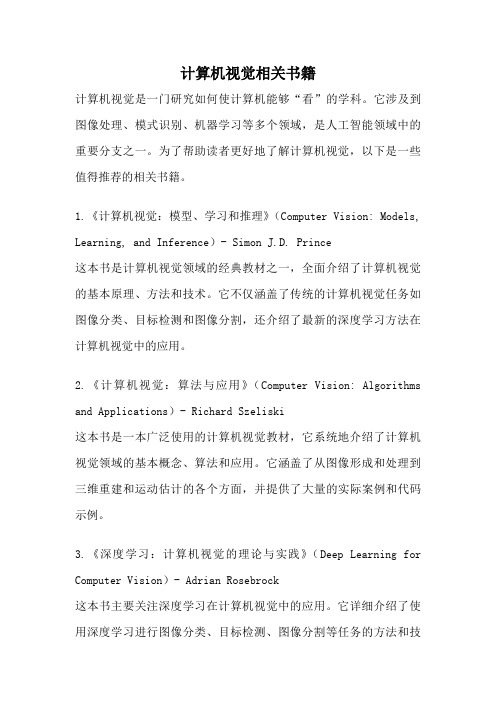
计算机视觉相关书籍计算机视觉是一门研究如何使计算机能够“看”的学科。
它涉及到图像处理、模式识别、机器学习等多个领域,是人工智能领域中的重要分支之一。
为了帮助读者更好地了解计算机视觉,以下是一些值得推荐的相关书籍。
1.《计算机视觉:模型、学习和推理》(Computer Vision: Models, Learning, and Inference)- Simon J.D. Prince这本书是计算机视觉领域的经典教材之一,全面介绍了计算机视觉的基本原理、方法和技术。
它不仅涵盖了传统的计算机视觉任务如图像分类、目标检测和图像分割,还介绍了最新的深度学习方法在计算机视觉中的应用。
2.《计算机视觉:算法与应用》(Computer Vision: Algorithms and Applications)- Richard Szeliski这本书是一本广泛使用的计算机视觉教材,它系统地介绍了计算机视觉领域的基本概念、算法和应用。
它涵盖了从图像形成和处理到三维重建和运动估计的各个方面,并提供了大量的实际案例和代码示例。
3.《深度学习:计算机视觉的理论与实践》(Deep Learning for Computer Vision)- Adrian Rosebrock这本书主要关注深度学习在计算机视觉中的应用。
它详细介绍了使用深度学习进行图像分类、目标检测、图像分割等任务的方法和技巧。
此外,它还介绍了如何使用流行的深度学习库如TensorFlow和Keras来实现计算机视觉应用。
4.《计算机视觉:现代方法》(Computer Vision: A Modern Approach)- David Forsyth, Jean Ponce这本书是一本综合性的计算机视觉教材,涵盖了计算机视觉的各个方面,包括图像处理、特征提取、目标检测、运动估计等。
它既介绍了传统的计算机视觉方法,又介绍了最新的深度学习技术在计算机视觉中的应用。
cvia标准
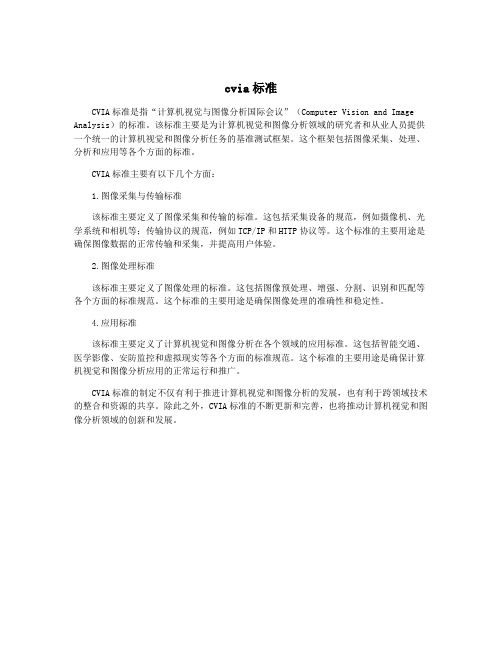
cvia标准
CVIA标准是指“计算机视觉与图像分析国际会议”(Computer Vision and Image Analysis)的标准。
该标准主要是为计算机视觉和图像分析领域的研究者和从业人员提供一个统一的计算机视觉和图像分析任务的基准测试框架。
这个框架包括图像采集、处理、分析和应用等各个方面的标准。
CVIA标准主要有以下几个方面:
1.图像采集与传输标准
该标准主要定义了图像采集和传输的标准。
这包括采集设备的规范,例如摄像机、光学系统和相机等;传输协议的规范,例如TCP/IP和HTTP协议等。
这个标准的主要用途是确保图像数据的正常传输和采集,并提高用户体验。
2.图像处理标准
该标准主要定义了图像处理的标准。
这包括图像预处理、增强、分割、识别和匹配等各个方面的标准规范。
这个标准的主要用途是确保图像处理的准确性和稳定性。
4.应用标准
该标准主要定义了计算机视觉和图像分析在各个领域的应用标准。
这包括智能交通、医学影像、安防监控和虚拟现实等各个方面的标准规范。
这个标准的主要用途是确保计算机视觉和图像分析应用的正常运行和推广。
CVIA标准的制定不仅有利于推进计算机视觉和图像分析的发展,也有利于跨领域技术的整合和资源的共享。
除此之外,CVIA标准的不断更新和完善,也将推动计算机视觉和图像分析领域的创新和发展。
基于二叉树结构的彩色图像分割
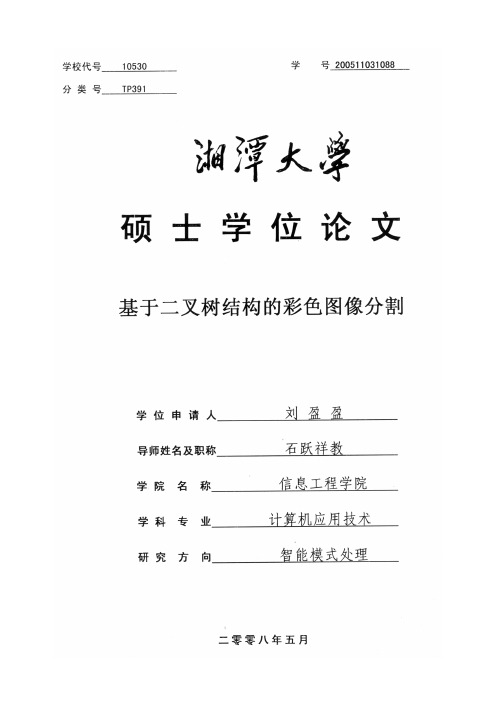
摘 要随着科学技术的进步和计算机的广泛使用,数字图像处理技术已经渗透到人类生活的各个方面,并发挥着越来越重要的作用。
图像分割就是指把图像分解成各具特性的区域并提取出感兴趣目标的技术和过程,它是由图像处理到图像分析的一个关键步骤,在计算机视觉、模式识别和医学图像处理等实际中得到了广泛的应用。
如何对彩色图像中的目标进行有效的分割是计算机视觉和图像分析的重点和难点,目前对彩色图像的分割方法主要分类为基于阈值的分割技术、基于边界的分割技术、基于区域特性的分割技术和结合特定理论工具的分割技术四类。
本文在传统的基于聚类算法的基础上,引入图像分层的理念,提出了一种基于二叉树结构的彩色图像分割方法,分层目的是将图像在不同分辨率下由粗到细地表达出来,基于分层的图像处理方法能够充分组合利用图像的全局与局部信息、空间与灰度信息.首先,对待分割图像采用最优阈值化方法获取R,G,B三个颜色空间的最佳阈值,从而得到三个颜色空间的二值图像,然后通过构造自适用二叉树进行一次粗分割提取目标区域,实现对图像的粗分割,自适应二叉树图像分块的基本思想是先把阈值化后的二值图像作为二叉树的根节点,以二值图像像素一致为基础,采用区域距离度量的方法进行区域分裂,在计算区域的距离时,我们需要考虑两个方面;区域的颜色距离和边缘距离,从而构造图像的分裂二叉树,得到图像的颜色一致区域。
通过构造二叉树进行粗分割可以把图像上颜色一致的区域初步的分割开,而并不理解其中的含义。
而且这样分割的图像往往呈方形,分割的结果不满足人们的视觉感知。
因此本文将在此基础上采用C-均值聚类算法实现对图像粗分割后形成的叶子区域进行聚类。
从而使分割后的图像更具有现实意义。
本文使用Visual C++ 6.0实现了算法,实验结果证明,本文所提出的方法与传统的区域生长方法和C-均值聚类算法的相比,可以更好的实现目标图像和背景的分离。
关键词:彩色图像分割,最优阈值化,二叉树,金字塔分割,聚类算法.AbstractWith the development of the science and technology and widely usage of computer, technology of digital image processing have come into everyday life and have an important effect on everybody. Image segmentation is just to segment an image into different sub-images with different characters and get some interested objects. It is a key step from image process to image analysis, plays an important role in image engineering, and is applied in a lot of fields such as computer vision, pattern recognition, medical image and so on..How to segment the target of the color image is the key and difficult of compute vision and Image Analysis. In recent years,People Separate image segmentation algorithms into 4 species.they are segmentation algorithms based on threshold , algorithms based on edge detection, algorithms based on regional characteristics,and algorithms combined with specific theoty.On the basis of the the traditional clustering algorithm and the concept of tiered.an effective segmentation method based on binary tree is proposed in this paper. The aim is to express image from fine to coarse according to different resolution. Image processing based on the images layered approach can take full advantage of global and local information of the image, space and gray information. In the way of the the method used segmentation method based on binary tree, first, this method uses the optimal threshold to get the best threshold in the R.G..B color space.thus gained the binary image of R,G,B color space.Then a roughly extract of the color image is gotten by constructing the self-adapting binary tree. the basic idea of the segmentation method based on binary is we use the binary image as the Root node first, based on the consistency of the pixel. we split the picture by measure the distance of regions,there are two respect we need to consider: the color distance and the edge distance.so we can obtain the binary tree of the image and the ,construction of the images so as to split the binary tree and the color coherent region. now the image is segmented to color coherent region segment but without understanding the meaning of the image.and the image was often square which dose not meet people's visual perception. After extracting, C_means clustering algorithm is used to improve the accuracy of the segmentation of the binary tree’s leaves. Experiments show that this method can separation of goals and background better compaare to the algorithms based on regional growth and clustering.Keyword: Color image Segmentation, Optimal threshold, Binary tree , pyramid segmentation,clustering algorithm;目 录摘要 (I)ABSTRACT (II)第一章绪论 (1)1.1研究的背景与意义 (1)1.2图像分割的数学描述 (3)1.3主要研究内容 (4)1.4论文的结构安排 (5)1.5本章小结 (5)第二章图像分割系统的一般结构 (6)2.1颜色特征及颜色空间的分析 (7)2.1.1颜色的基本性质 (7)2.1.2颜色空间 (7)2.2 图像分割的研究现状 (9)2.2.1 基于直方图阈值的方法 (10)2.2.2基于区域的方法 (11)2.2.3 基于边缘的方法 (14)2.2.4基于颜色聚类的算法 (16)2.2.5基于特定理论工具的算法 (18)2.3本章小结 (20)第三章基于二叉树的图像分割 (22)3.1基于分层结构的图像分割 (22)3.1.1金字塔缩减过程 (23)3.1.2金字塔分割方法的优缺点 (24)3.2基于自适应二叉树的图像分割 (25)3.2.1图像的二值化 (25)3.2.2自适应二叉树图像分块 (27)3.2.3 C-均值聚类算法 (29)3.3本章小结 (33)第四章实验分析 (34)4.1试验过程与分析 (34)4.2对噪声图像的处理 (36)4.3与其他算法计较 (37)第五章总结与展望 (39)5.1总结 (39)5.2展望 (39)参考文献 (41)致谢 (46)附录A 攻读硕士学位期间公开发表的学术论文 (47)第一章 绪论1.1研究的背景与意义在人类接收的信息中有80%来自视觉或者说为图像信息,这是人类最有效和最重要的信息获取和交流方式。
- 1、下载文档前请自行甄别文档内容的完整性,平台不提供额外的编辑、内容补充、找答案等附加服务。
- 2、"仅部分预览"的文档,不可在线预览部分如存在完整性等问题,可反馈申请退款(可完整预览的文档不适用该条件!)。
- 3、如文档侵犯您的权益,请联系客服反馈,我们会尽快为您处理(人工客服工作时间:9:00-18:30)。
IMAGE ANALYSIS AND COMPUTER VISION FOR UNDERGRADUATESAndrea CavallaroMultimedia and Vision LaboratoryQueen Mary, University of LondonMile End Road, London E1 4NS (United Kingdom)Email: andrea.cavallaro@ABSTRACTReal hands-on experience can help students gain a better understanding of theoretical problems in image analysis and computer vision and allows them to put in practice and improve their knowledge in digital signal processing, mathematics, statistics, perception and psychophysics. However, important efforts are necessary to enable students to develop a computer vision application because of the lack of extensively tested and well documented software platforms.In this paper, we describe our experience with an open source library addressed to researchers and developers in computer vision, the OpenCV library, its limits when used by students, and how we adapted it for teaching purposes by producing a set of appropriate tutorials. These tutorials help the students reduce the average time for installation and setup from 1 week to 4 hours and help them design an end-to-end image analysis and computer vision project. Finally, we discuss our experience of using this framework for undergraduate as well postgraduate student projects.1. INTRODUCTIONVideo-based systems are becoming an important part of many applications around us, such as automated video surveillance, video-based human machine interfaces, and immersive gaming. Such a development has created a market demand for students trained in this area and in fact an increasing number of universities are proposing courses in image analysis and computer vision.Although it is easy to generate interest in students while teaching these subjects, it is much more difficult to help them have a practical experience in the design of a computer vision application by means of a project. Computer vision projects allow students to put in practice and develop their knowledge in mathematics, statistics, digital signal processing, perception and psychophysics. Although it is possible to implement MATLAB laboratory sessions for low-level image analysis functions, it is much more difficult to allow the students to design and to implement a real-world, real-time application such as object detection and recognition, video-based human-computer interfaces, mixed reality, or object tracking.We experienced some problems in letting students start an undergraduate computer vision project from scratch or with software borrowed from our research projects: it took them too long to get started, thus reducing the time available to really learn about computer vision. The ideal solution to this problem would have been a well commented software platform and a library providing all the basic data structures and their operators, basic functions or classes for reading data from a video camera or from a file, displaying a video or writing a video file, functions for computing the optical flow, filters for tracking and edge detection, and so on, as well as more advanced functionalities to demonstrate the capabilities of the library to the students. The Intel OpenCV library [1] appeared to be the best candidate for such a platform. However, we realized that the software was not adequately commented and documented for our purpose (the library is in fact addressed to researchers and professionals, not to undergraduate students) and the time taken by the average student to correctly install the software package, additional software required, and to understand how to use it was still prohibitively high.Given the large number of useful functions of the OpenCV library, we decided to improve the documentation in order to enable undergraduate students to use the potentiality of this library for their projects. This resulted in three main documents that we now use to guide the students in the installation of the OpenCV software, the additional packages needed to receive data from a video camera and a tutorial on how to write a simple computer vision application. We will discuss these documents and the way we organize the projects in Section 2. Section 3 reports some examples of projects, whose reports in turn become part of the library documentation. In Section 4 we evaluate our experience with the platform. Finally, in Section 5 we draw the conclusions.2. STUDENTS’ PROJECTS WITH OPENCVWe describe here the structure of the image analysis and computer vision project module and the documents containing tutorials that made the OpenCV library accessible to undergraduate students. The objective of this module is a design, development, or research project during which students produce a real-time application. The project enables students to appreciate the components of a computer vision system, to develop their skills in signal processing and in C and C++ programming. In addition to this, the module gives students experience of managing their own time to complete a project and«of developing their communication skills, both written and oral, to a standard expected by industry of a new graduate. The outputs of the project are a report, a demonstration, a presentation, and an oral examination. The project normally occupies about 240 hours, spread over 2 semesters, and can take the form of an individual or a group project. In the case of a group project, the aim is also to give students experience in working as a team, communicate among each others and manage a more complex project. In fact, individual projects usually start from the information available in the tutorials, whereas group projects (in general 6 people) start from already existing projects and build up more complex applications. In such a way, students also appreciate the importance of good commented and documented software.Students are first given an introductory lecture on the objective of the project and the OpenCV library. Then they are given three tutorials produced to help them start. The first tutorial is the installation guide, which helps install the OpenCV library for use with Visual Studio and Direct X SDK. The second is a guide to creating the workspace and project for OpenCV. The final guide shows how to write a real-timeapplication, a background subtraction algorithm using the library and a web camera. Thanks to the three tutorials, the average undergraduate student is able to have his/her first real-time computer vision program running in about 4 hours. In addition to the tutorial and the OpenCV documentation, students have also access to previous project reports which complete and enrich the basic documentation of the library.3. PROJECT EXAMPLESIn this section we describe and discuss examples of projects developed by the undergraduate students based on the framework described in Section 2. The projects are based on real-world applications, such as video surveillance, video production (e.g., weather forecast programs with the presenter superimposed on a map), interactive and immersive games.The first example of project is object detection based on background subtraction. Background subtraction allows one to detect moving objects using a static camera. This is a simple and effective example of real-time application where students appreciate and learn about problems caused by different lighting conditions, camera noise, and shadows. Starting from a simple thresholded pixel-by-pixel image difference (Figure 1), the students understand how to use morphological and low-pass filters [2,3], re-sampling and statistical analysis [4]. In addition to the above, they learn how to use statistical approaches for the generation of a background frame.The completion of the previous example enables the students to develop other applications, such as object tracking (Figure 2). Working on object tracking, students understand the importance of feature representations and of color space conversions, the use of distance functions in the feature space, and different tracking algorithms. Furthermore, they learn how to disambiguate between similar objects by choosing the appropriate set of features to describe them. In particular, they experience several histogram comparison functions, such as the Ȥ2, the correlation methods, and the Bhattacharyya distance. They learn and test the difference between color spaces and the properties of photometric invariant color features [5].(d) (e) (f)Figure 1. Example of thresholded background subtraction result (a) undergoing different morphological filtering: (b) single erosion, (c) recursive erosion. (d) After down-sampling, (e) after down-sampling followed by up-sampling.(f) After statistical analysis.Figure 2. Example of object detection and tracking based on background subtraction and color histogram distance.This allows them to design algorithms that differentiate objects from their shadows.Another application enabled by the results of background subtraction is m ixed reality (Figure 3). This application allows students to understand how to write algorithms for video production and how to solve different problems related to ambient lighting and to the composition of several inputs.Other projects that do not necessarily require the use of background subtraction are based on the design of perceptual hum an-com puter interfaces (Figure 4). Figure 4 (a) shows an example of a rem ote control simulated by tracking hand gestures. Here, the tracking is based on a model of the hand defined by color and edge information. Moreover, face detection [6] is used to disambiguate between the hands and the face. The project shown in Figure 4 (b), called the virtual artist, allows one to draw lines on the screen without using any device. In both applications, students learn how to define and use a model of an object and how to track it over time. A particular aspect covered when developing these applications is the analysis of the¬(a) (b)(c) (d)Figure 3 Example of real-time mixed reality application. (a) Background frame learned and updated over time; (b) current frame; (c) new background frame (synthetic or real); (d) object-based scene composition.precision of the tracking. Students evaluate the results in terms of user satisfaction and in terms of objective metrics (accuracy).We conclude this section presenting two applications that are usually very motivating for students and enable them to use their creativity, namely the design of special visual effects and of video animations. Special visual effects can be generated based on background subtraction and on the use of video object memory (Figure 5 (a)). Video anim ation is based on tracking: moving objects can control the movement of avatars or simple symbols (Figure 5 (b)).4. EVALUATION AND ASSESSMENT4.1. Learning outcomesLearning outcomes for the image analysis and computer vision projects can be divided into two groups, namely subject specific skills and transferable skills. In terms of learning outcomes in subject specific skills, students learn to employ signal processing, mathematical and software 'tools' to a familiar or unfamiliar situation. In particular, we experienced that the opportunity to develop ‘good looking’ applications, which hide a good amount of theoretical studies and concepts, helped motivating the students. Interestingly, this aspect also motivated some of the students to go far beyond their project specifications and to learn more on the subject. Furthermore, the possibility of developing real-time computer vision applications seems to be very rewarding for the students and at the same time allows them to have fun (see examples in Section 3).In terms of learning outcomes in transferable skills, students learn to manage time effectively and produce written progress reports and a final report on time. In addition to the(a)(b)Figure 4 Examples of perceptual human-computer interaction. (a) Video-based remote control: a vertical movement of the hand changes channel (Up: next channel, down: previous channel; Left (right) decrease (increase) the volume). (b) Virtual artist: with the movement of the hands the student can draw in different colors that can be selected in the corners of the image.experience with signal processing and computer vision, the projects allow the students to appreciate the importance of writing software that can be easily reused. Students working in group build their work on top of other students’ work and therefore appreciate the problems one encounters when software is not well commented and documented.4.1. AssessmentOpenCV is becoming widely used by the research community. Since its release as freeware, the OpenCV library has been downloaded over half a million times and the official yahoo group has over 5000 members. However, when we joined the group, we found no answers to our queries and we received ourselves a large number of questions. One of the reasons for this is that the OpenCV library is aimed at users with an in-depth understanding of computer vision. Furthermore, there is little documentary support for the functions.The creation of the tutorials and the use of students’ report as additional documentation to the library facilitate the use of OpenCV. Although students find it hard to start their imageanalysis and computer vision project, they usually get ¬(a)(b)Figure 5 (a) Example of special visual effects generated with background subtraction and the use of object memory. (b) Example of object animation based on tracking. The motion of the tracked people (left) controls the movement of symbols (right)enthusiastic when they succeed in showing to their peers what they were able to design and with a common personal computer and a web camera. This in turn generates interest for the subject in other students and could also be used as part of universities strategies for widening participation. For example, a group of students found it very rewarding to present their work at the University Open Day and their demos had a very good appeal to high school students.An important advantage of adopting OpenCV for teaching purposes is that it is open source. This not only reduces costs but also allows the increasing number of students with their own computer and a web cam to work at home and to continue using the library after the project.In addition to the above, the platform is very useful for providing the students with practical examples in class during the lectures to support the theoretical part of the course.To conclude, we report here some feedbacks received from the students after completing their projects:“This project had the “excitement” factor, being able to work with live camera feeds and manipulating the input to achieve desired effects as well as for fill our goals.”“I feel a little extra background information on OpenCV could have helped us achieve a little more.”“Although the project was a learning curve for me it was also a fun and enjoyable at the same time.”“I think it was well worth the effort, and we were all very pleased with what we had produced.”5. CONCLUSIONSLaboratory hands-on experiments and projects are a very effective way to learn subjects such as signal processing and computer vision. We presented the framework that we developed and we use to enhance the quality of learning in image analysis and computer vision at undergraduate level based on the OpenCV library. Providing additional documentation to the library and project examples opened a window of opportunity for student projects that was not available at an undergraduate level.All the projects produce a user guide and functional documentation in order to complement and enhance the functions available in the OpenCV library. The framework and the documentation are continuously updated with new projects and additional tutorials are provided as the number of applications increases.6. ACKNOWLEDGMENTSWe would like to acknowledge the effort of the students Navin Kerai, Bhavin Padhiar, Lad Ketanbhai, Randip Singh Bahra, Muhammad Razwan Aslam, and Khalid Saeed Allahawala who helped set up the framework described in this paper.7. REFERENCES[1] G. Bradski, “The OpenCV Library”, Dr. Dobb’s Journal November 2000, Computer Security , 2000.[2] A. K. J ain, Fundam entals of Digital Im age Processing ,Prentice Hall, 1988.[3] A. Bovik, Handbook of Im age and Video Processing ,Academic Press, 2000.[4] A. Cavallaro, T. Ebrahimi, "Interaction between high-level and low-level image analysis for semantic video object extraction", Journal of Applied Signal Processing , No. 6, pp. 786-797 June 2004.[5] E. Salvador, A. Cavallaro, T. Ebrahimi, "Shadow identification and classification using invariant color models", in Proc. of IEEE Int. Conf. on Acoustics, Speech, and Signal Processing, Salt Lake City (Utah-USA), pp 1545-1548, 2001. [6] P. Viola and M. J ones, “Rapid object detection using a boosted cascade of simple features”, in Proc. of IEEE Int. Conf. on Computer Vision and Pattern Recognition, 2001.¬。
